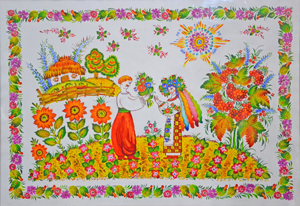“Petrykivka paintings will always be modern art”
People in Ostroh Academy and in France can enjoy the unusual ornaments. There is also an exhibition of Petrykivka paintings planned by UNESCO
In recent years in Ukraine there has been a growing interest in traditional folk decorative art that is being updated and acquires new forms and values. This also applies to the famous Petrykivka paintings that originates from the ancient mural painting and exterior of house interior common in Dniporpetrovsk region, Podillia, and Bukovyna. Already in the 17th century Petrykivka ornaments were spread throughout Ukraine. Each region has given it an individual ethnic color and, at the same time, brought its own touches to traditional painting.
Of course, the cradle of the painting style was the village of Petrykivka, which keeps and develops the best traditions of this kind of folk art up until present days. It was Petrykivka that became the center of making, so called, “maliovkas” – drawings on thin paper that are made using aniline dyes – “maniikas.” This kind of Petrykivka painting amazes with the clarity of colors, pureness of fine compositions, and unusual display of nature.
In Petrykivka along with reproduction of traditional folk ornaments and paintings individual art has gradually established itself. Currently there is a center of folk art operating in the village. There are over 30 masters working there and their best art works are now presented in the Art Gallery of Ostroh Academy. The exhibition opened at the initiative of the Association “Ukraine-France,” regular partner of the International Relations Department of the University.
Curator of the exhibition – vice president of the Association – Pavlo Rotar believes that folk art and Petrykivka paintings in particular is something through what Ukrainians can express themselves on a global level: “Petrykivka paintings will always be modern art because it is made in any epoch. Of course, time makes its adjustments: ornaments change, technical facilities for painting are improved, and only the ideological content of Petrykivka paintings remains the same. Ukrainians could develop Petrykivka traditions much better if they used this painting style not only in painting, but also in printing, porcelain, faience and textile industries.”
Craftswomen from the Center of Folk Art Iryna Kibets and Lina Skliar, whose works were included in the general exposition, held a master class for students on the technique of Petrykivka painting and by doing that they demonstrated the easiness of painting and possible use of locally improvised materials, mixing both established schemes and one’s own imagination in painting.
Today not only visitors of Ostroh Academy have a chance to enjoy the art works made by Petrykivka painting masters. Such exhibitions are systematically organized in regional museums and galleries of Ukraine. Since October 2011 an exhibition of Petrykivka paintings is open in the Cultural Center at Ukrainian Embassy in France. The exhibition presents works by Halyna Nazarenko. Hundreds of visitors came to see it because the last exhibition similar to this was held in France nearly 25 years ago. The organizers of the exhibition are certain that now French men see Ukraine in a somewhat different way because in their culture they don’t have any similar example of modern art with ancient roots.
At the moment Rotar is collecting as many paintings as possible for an exhibition of Petrykivka painting in UNESCO. He said that such project could grant this art the status of “man-made heritage of world culture,” which would be a major step in promoting and developing Petrykivka ornaments.






